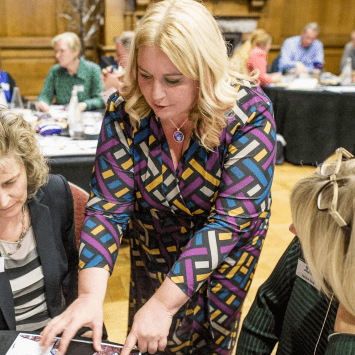Posted in Blog, Eco-innovation, Innovation, Sustainability by Jo North
How You Can Lead Sustainable Innovation in 2025
Sustainable innovation is a critical strategy for businesses. It drives long-term value for businesses, society, and the environment. I have decades of experience in helping organizations achieve sustainable growth. My book, Leading Sustainable Innovation, outlines proven methods and innovative strategies for success. This guide builds on those principles to help lead sustainable innovation to make an even more meaningful impact in 2025. And just a note – all the tools, platforms etc that I link to here are just suggestions to show you what’s out there, and inspire you to look for solutions that will work well for you. See them as a launchpad to explore the art of the possible, rather than recommendations.
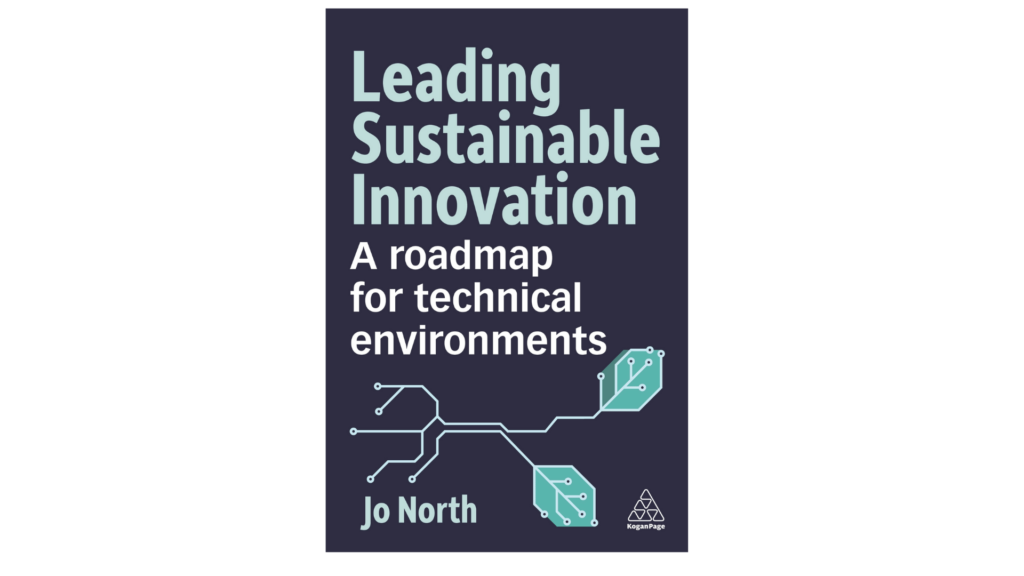
Understanding the Concept of Sustainable Innovation
What Is Sustainable Innovation?
Sustainable innovation involves implementing ideas that simultaneously benefit business, society, and the environment.
You can achieve this by integrating renewable energy sources, reducing waste through circular economy practices, and leveraging technology such as AI-driven energy management systems. For example, as a startup, focus on modular product designs that allow easy upgrades and repairs, minimizing resource consumption. If you run a larger organization, consider implementing supply chain optimization tools to track and reduce emissions. Embedding these practices into your growth strategies ensures you not only meet current demands but also build resilience against emerging challenges whilst driving meaningful progress.
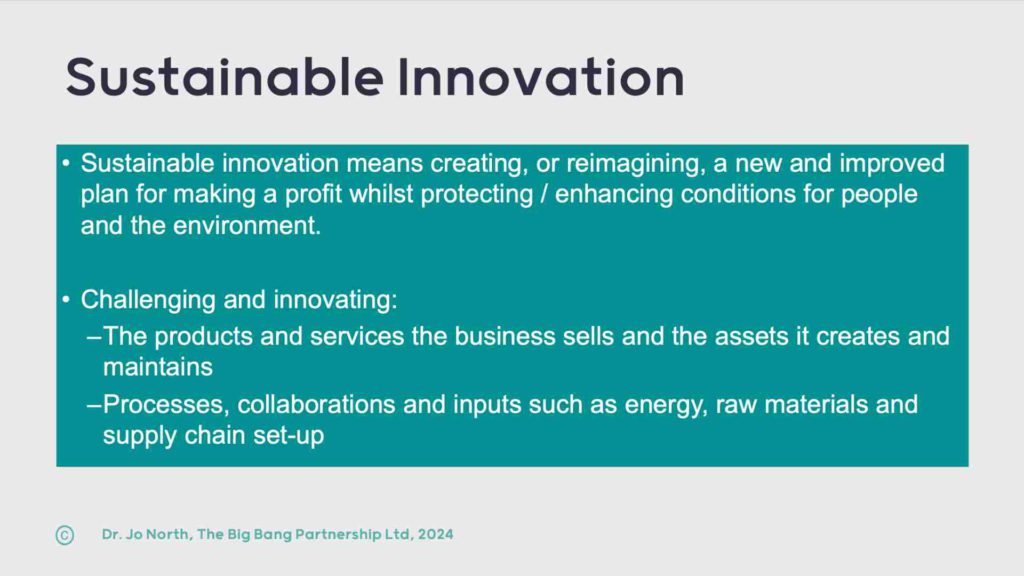
The Benefits of Sustainable Innovation
Sustainable innovation leads to measurable benefits. It reduces carbon emissions, improves operational efficiency, and creates social benefits for communities. Meeting customer demand for sustainable products and services can boost profitability by tapping into growing market preferences. Employees, especially newer generations entering the workforce, find sustainable innovation motivational and engaging. Aligning values fosters creativity and strengthens team commitment to achieving shared goals.
Setting the Foundation for Sustainable Practices
Aligning With Sustainable Development Goals (SDGs)
The SDGs (Sustainable Development Goals) are a set of 17 global objectives established by the United Nations to address urgent environmental, social, and economic challenges. They serve as a framework for promoting prosperity while protecting the planet. These goals include eradicating poverty, improving health and education, reducing inequality, and tackling climate change. While the goals are ambitious, you don’t need to tackle all 17 at once. Instead, focus on the goals most relevant to your business by using a materiality matrix.
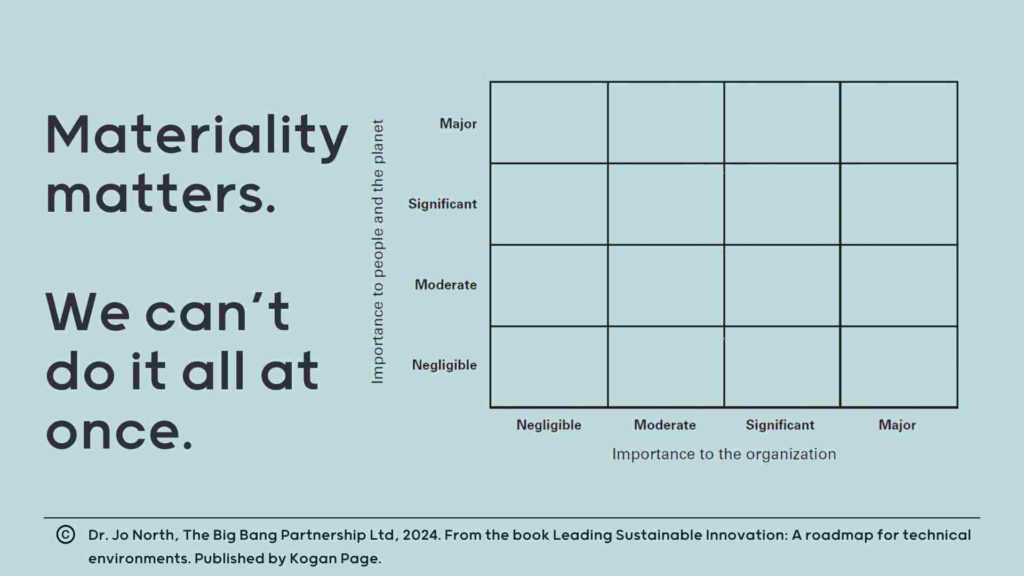
The materiality matrix helps you prioritize which goals align with your business impact and stakeholder expectations. For example, a manufacturing company might prioritize goals related to responsible consumption and production, while a tech startup might focus on innovation and infrastructure. Once you’ve identified key priorities, set clear targets for renewable energy adoption or waste reduction.
If you are a startup, consider leveraging early-stage programs offered by initiatives like the UN Global Compact. These programs provide guidance, mentorship, and access to global networks. Another option is to pursue B Corp certification, which demonstrates your commitment to social and environmental performance, accountability, and transparency.
Larger organizations can integrate SDG principles into their strategic plans by aligning corporate goals with these frameworks: The Science Based Targets initiative (SBTi) helps businesses set climate goals consistent with the Paris Agreement. Industry-specific programs, such as the Responsible Steel Standard or the CDP (formerly Carbon Disclosure Project), offer recognized frameworks for measuring and managing sustainability performance.
Make sure that you regularly measure your progress, using tools like ESG software such as Enablon (investor-grade ESG strategy), Sphera (chemicals) or EcoTrack (fleet management) to track outcomes and refine your approach. You’ll need to find solutions relevant for your industry, but these platforms help monitor sustainability metrics, compliance, and performance across various domains. Structured alignment ensures your efforts create both immediate results and a strong foundation for long-term impact.
Building a Structured Approach to Sustainability
Using Specialized Tools
To enhance your sustainability efforts, integrate tools like iCor, which helps you track your environmental compliance for ISO 14001. CarbonLnk helps businesses offset emissions across their supply chain. It connects them with verified carbon credits, creating a practical route to carbon neutrality. Companies can track, manage, and offset their footprint, boosting their sustainability goals with clear data and real-time insights. Additionally, Airnode simplifies real-time environmental data integration. It helps businesses gather, track, and analyze crucial metrics to reduce inefficiencies. This proactive approach means issues get spotted early, leading to lower waste and better sustainability outcomes.
Step 1: Conduct a Sustainability Audit
Examine your operations thoroughly. Evaluate energy use, waste management, and supply chain practices. Identify specific inefficiencies that hinder sustainability. Use tools like CarbonChain to analyze emissions across the supply chain and identify hotspots for improvement.
Step 2: Prioritize Key Areas for Improvement
Focus on the most impactful areas, and spot your sustainable innovation blindspots. For instance, if energy consumption is high, explore renewable energy options. If waste levels are significant, assess recycling and circular economy practices. Companies such as TerraCycle offer specialized programs to help reduce and repurpose waste streams. They collect difficult materials, like wrappers or coffee pods, and transform them into new products. They also partner with brands and retailers to reduce waste through these specialized recycling programs.
Step 3: Create a Plan with Actionable Steps
Outline clear actions to address inefficiencies. For example, set a timeline for transitioning to renewable energy sources or implementing waste reduction programs. Ensure each step has an owner and a deadline.
Step 4: Set Short- and Long-Term Goals
Define measurable objectives. Short-term goals might include reducing energy consumption by 10% within six months. Long-term goals could focus on achieving net-zero carbon emissions within five years. Incorporate KPIs that align with your business’s sustainability vision.
Step 5: Assign Responsibilities and Resources
Ensure accountability by assigning tasks to specific team members. Allocate sufficient resources, such as budgets for new technology or training programs. Look into the Carbon Literacy program for your employees.
Step 6: Monitor and Review Progress Regularly
Track your progress using metrics like energy savings or waste reduction percentages. Schedule regular reviews to assess outcomes, address challenges, and refine your approach as needed. Consider leveraging dashboards Tableau for real-time sustainability data visualization. Other options include Diligent ESG for tracking sustainability goals, and SustainaBase, which simplifies carbon footprint analysis and data aggregation. These platforms cater to different business needs and scales, making it easier to align with your sustainability objectives.
Key Strategies for Driving Sustainable Innovation
Take Advantage of Technological Advancements
Technology can play a pivotal role in advancing your sustainability goals, of course. Start by integrating digital tools like IoT sensors to monitor energy consumption and greenhouse gas emissions in real-time. Platforms such as CarbonCure, used by construction firms in 2024, demonstrated how CO2 emissions from concrete production could be reduced by injecting captured carbon into fresh concrete during mixing. Similarly, small-to-mid-sized manufacturers have adopted platforms like Pavegen, which generates renewable energy from foot traffic in factories and retail spaces, showcasing the innovative use of overlooked resources. Also explore specific, net zero technology relevant to your company’s activities.
Use AI and Data for Sustainability
AI-powered energy management systems can also revolutionize your operations. For instance, in 2024, Grid Edge’s AI-driven platform helped UK-based utility companies predict energy demand with 95% accuracy, minimizing waste and improving energy efficiency.
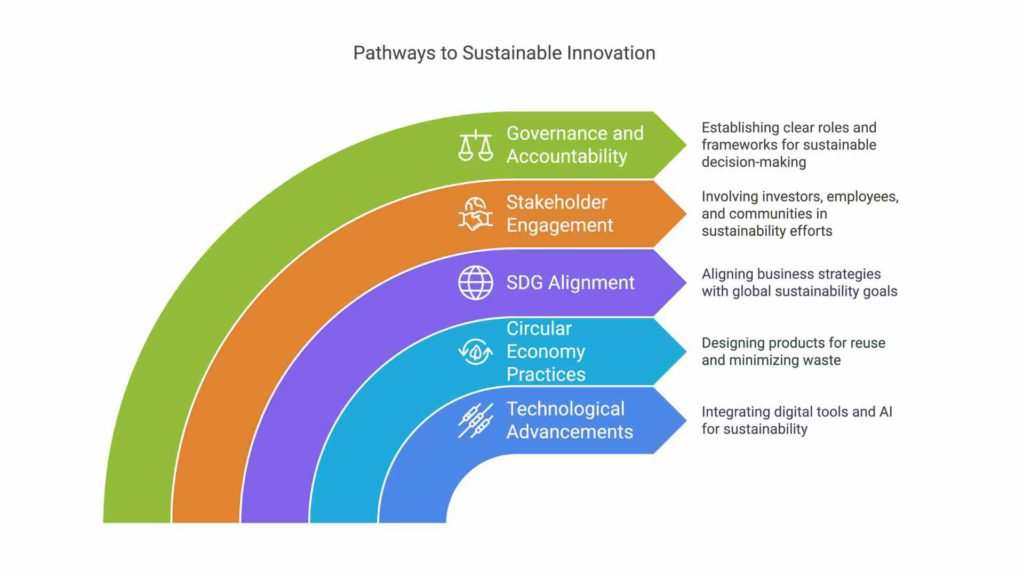
Creating Innovative Products and Business Models
Designing Products With Sustainability in Mind
To stand out in sustainability, you need to go beyond the basics. Eco-innovation begins by exploring ways to create products that use fewer raw materials or are designed for reuse and recyclability. For instance, companies like Ecovative have pioneered mycelium-based packaging in 2024, which offers a compostable alternative to plastics. Sustainable design principles can also include modularity, allowing easy repair or upgrading.
Circular Economy Practices
Adopting circular economy practices can unlock untapped potential. Look at businesses like Loop, which partners with brands to sell products in reusable packaging, creating a closed-loop system that minimizes waste. Startups can explore models like product-as-a-service to align profitability with sustainability. For example, furniture-as-a-service companies reduce overproduction by enabling customers to rent high-quality items instead of purchasing.
Experimentation
Empower your innovation teams to challenge conventional ideas by creating a culture of bold experimentation. Use design sprints to address specific sustainability challenges, creating actionable outcomes within tight timelines. Encourage cross-functional collaboration to combine diverse perspectives. Here’s a full, free guide to running a business sustainability workshop for your team.
Instead of relying solely on traditional brainstorming, incorporate biomimicry—an approach that draws inspiration from nature to solve design problems. For example, adhesives modeled on gecko feet offer strong, recyclable alternatives for industrial use. Partner with incubators and sustainable innovation accelerators, such as Made Smarter, to access emerging technologies and support system-wide innovation.
Enhancing Operational and Environmental Efficiency
Energy Efficiency and Renewable Energy Sources
Improving energy efficiency reduces costs and environmental impact. Explore how you might to renewable energy sources like solar or wind power. Businesses that invest in energy efficiency often see rapid returns on investment.
Supply Chain Optimization
Transform your supply chain by adopting sustainable practices. Focus on sourcing raw materials responsibly and improving waste management. Optimizing your supply chain reduces environmental footprint while enhancing operational efficiency. Tools like Rheaply, which facilitates resource sharing among businesses, can make unused materials available for reuse rather than disposal. Look for similar schemes in your local area.
Investment Decisions for Sustainable Innovation
Leaders of sustainable innovation face tough decisions. They must weigh financial returns against environmental and social impact. Success depends on balancing short-term costs with long-term benefits.
Redefine ROI for Long-Term Value
The traditional view of return on investment (ROI) is too narrow. Effective leaders in 2025 must redefine value to include environmental and social metrics alongside financial outcomes. Emphasize Whole Life Value (WLV), which captures economic, social, and environmental benefits over time. This approach enables you to make stronger cases for investments in green technologies or projects like renewable energy infrastructure or zero-carbon facilities. Measure success not just in quarterly results but in the long-run resilience and viability of the business, whilst also being mindful of cashflow considerations.

Key Factors to Balance
Sustainability Goals: Align investments with business goals, net-zero targets, resource efficiency, and circular economy practices. Use frameworks like Whole Life Value (WLV) to capture the full impact of decisions.
Risk and Uncertainty: Address risks tied to emerging technologies or market shifts. Build resilience into decisions and anticipate future regulations.
Stakeholder Expectations: Engage investors, employees, and communities. Transparent reporting on Environmental, Social, and Governance (ESG) metrics helps build trust and align interests.
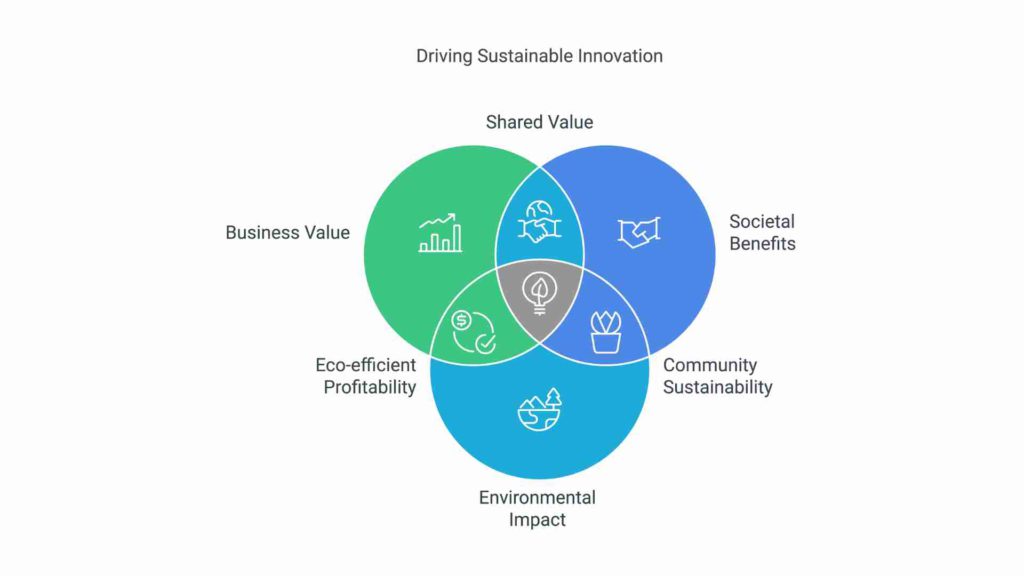
Balance Innovation With Practicality
Disruptive innovation is important, but it must be balanced with actionable, scalable solutions. Too often, ambitious projects stall because they fail to consider scalability or alignment with existing infrastructure. Leaders must weigh technological feasibility, regulatory requirements, and stakeholder expectations. For example, while electric vehicles (EVs) are critical for decarbonization, ensuring sufficient charging infrastructure is equally vital. Focus on end-to-end solutions rather than standalone innovations.
Plan for Long-Term Success Amid Uncertainty
Sustainability requires agility in a world of rapid change. Develop scenario-planning capabilities to anticipate shifts in regulations, resource availability, and market demands. Build resilience by diversifying your resource base, investing in adaptable systems, and fostering partnerships that enhance your flexibility. Long-term success depends on your ability to evolve with, rather than react to, changing conditions.
Governance and Accountability
Good governance ensures consistent decision-making. Establish clear roles, from project sponsors to technical experts. Use robust frameworks to evaluate projects based on sustainability, affordability, value, time, and risk.
Regular reviews of KPIs and progress tracking are critical. Tools such as materiality analysis (above) help prioritize efforts with the greatest impact.
Combine sustainable innovation with accountability. Investment strategies should reflect purpose-driven goals, while supporting collaboration across teams and partners for sustainable growth and meaningful change.
You could use a decision-making matrix such as the one below, extracted from my book, Leading Sustainable Innovation, to support your decision-making.
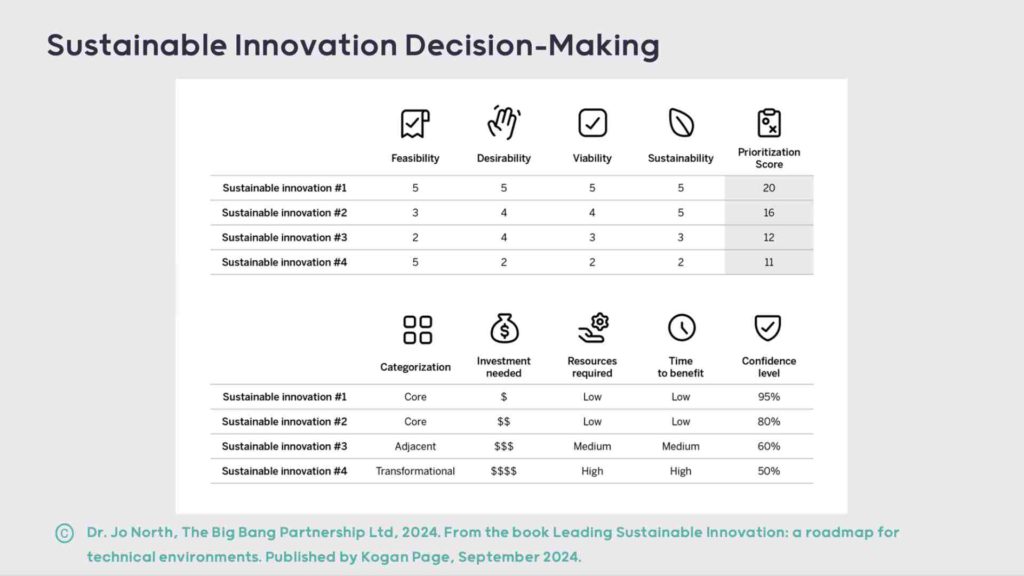
How You Can Lead Sustainable Innovation in Your Team
Collaborative Approach
Collaboration is critical. Partner with your innovation ecosystem – i.e. other business owners, governments, and non-profits to share resources and insights. For example, the 2024 CleanTech Challenge is a global business plan competition for students with innovative clean technology ideas. Hosted by London Business School in conjunction with University College London, the challenge is sponsored by Gore Street Capital. Applications for the 2025 Clean Tech Challenge are now open. Platforms like Solve by MIT support collaboration by connecting tech-based social innovators with funders and experts.
Innovation Culture
Cultural inertia is one of the biggest barriers to sustainable innovation. Leaders need to embed a sustainable innovation culture into the organization’s DNA. This means creating accountability at all levels. Set specific, measurable goals tied to KPIs, such as reducing carbon intensity or increasing sustainable sourcing. Reward teams for innovative ideas that meet or exceed these targets. Ensure leaders at every level model the behaviors and values they expect from their teams.
Learn from Failure
Examine why certain sustainable initiatives succeeded or failed. For example, recent projects in urban renewable energy systems or EV infrastructure reveal common pitfalls, such as underestimating the time required for stakeholder buy-in or overlooking operational challenges. Use these lessons to refine your strategy and avoid repeating mistakes.
Stakeholder Engagement
Stakeholder engagement creates trust and alignment. It uncovers potential risks and shared priorities. It boosts credibility and secures support for your goals.
Make sure that you have a clear stakeholder map for your business. Reach out to key stakehilders early in your planning. Ask for input and encourage open dialogue. Provide regular updates on progress and address concerns promptly. Invite stakeholders to workshops or short sessions or events where they can share insights and solve problems together. Involve users to make sure that your sustainable innovations are inclusive.
Celebrate small wins and recognize contributions. Show how feedback leads to tangible improvements. Maintain clear, consistent communication to build loyalty and keep everyone motivated for sustainable innovation in 2025.
Innovate With Equity in Mind
Sustainable innovation that ignores social inequality is incomplete. Leaders must ensure that, where possible, projects deliver benefits to underserved communities and help to address social problems, such as equitable access to clean energy or sustainable housing. By integrating social enterprise models into your strategy, you create solutions that are both inclusive and sustainable.
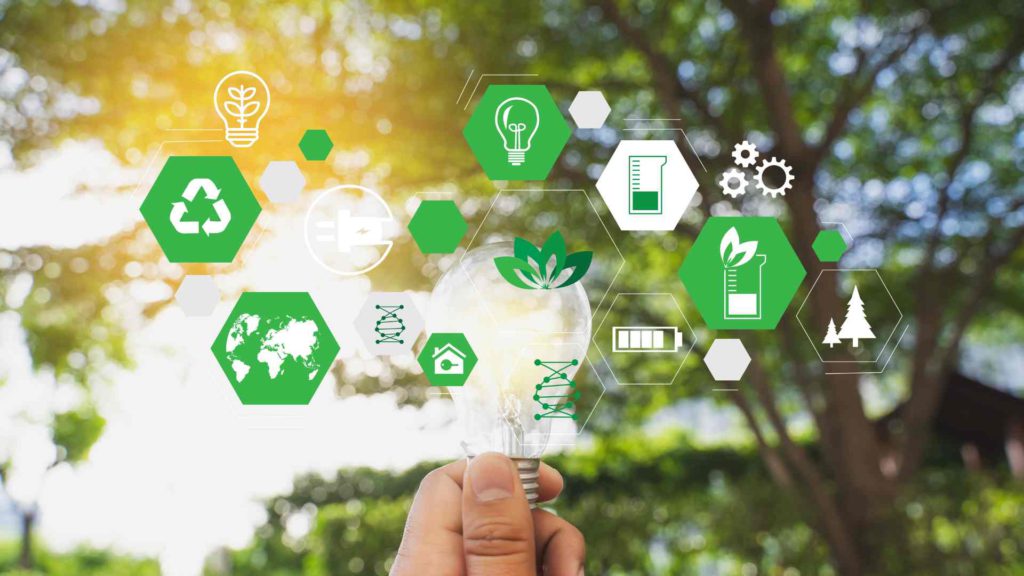
Adopt a Holistic Approach
A holistic approach integrates sustainability into every aspect of your business. Address environmental sustainability and social responsibility together. Taking this approach ensures your innovation strategies have a broader and deeper impact. Consider incorporating community-based initiatives to engage local stakeholders and generate shared value.
Sustainability issues are interconnected. Leaders need a systems-thinking approach to understand the cascading effects of decisions. This means moving beyond isolated initiatives and examining the entire lifecycle of operations, from supply chains to end-of-life processes. For example, integrating circular economy principles—such as designing products for disassembly and reuse—can reduce waste and maximize resource efficiency across the value chain. Build teams that can analyze these connections and propose integrated solutions.
Develop Competitive Advantage
Sustainable entrepreneurship and green innovation provide a significant competitive advantage. Companies that prioritize sustainability often attract more customers and investors. Use sustainable growth to gain market share and strengthen your reputation.
Use Regulatory Changes as Opportunities
Environmental stewardship often requires compliance with increasingly stringent regulations. Instead of viewing these as constraints, treat them as opportunities to innovate. For example, many large companies are redesigning supply chains to meet upcoming net-zero mandates. By proactively addressing regulatory changes, you can position your business as a leader rather than a follower, turning compliance into competitive advantage.
Leading Sustainable Innovation in 2025: The Way Forward
Leading sustainable innovation is essential for business success in 2025. It reduces environmental impact, addresses global challenges, and creates long-term value. By leading with a clear strategy, leveraging technology, and collaborating with others, you can drive meaningful change. If you’d like to create a detailed roadmap for your business, my book, Leading Sustainable Innovation: a roadmap for technical environments, will take you through the process step-by-step. If you’d like to explore hands-on consulting for your sustainable innovation strategy and plans, or would like me to speak at a forthcoming event, please do get in touch with me direct here.
